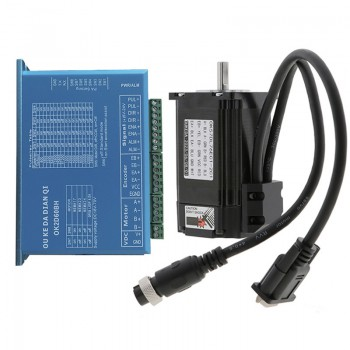1.Basic knowing about the stepper motor
A stepper motor is a brushless DC motor that rotates in precise, fixed angular increments (steps) instead of continuous motion, controlled by digital pulses, making it ideal for precise positioning without feedback sensors (open-loop control). Its internal structure (stator with coils and a toothed rotor) allows for exact positional knowledge by counting steps, enabling applications in 3D printers, CNC machines, and robotics for tasks needing high accuracy and repeatability, from driving lead screws to positioning optics.
2.Main working of stepper motor
1.Components: A stepper motor consists of a stationary part called the stator (with multiple electromagnetic coils/windings) and a moving part called the rotor (usually a permanent magnet or soft iron core attached to the shaft).
2.Initial Energizing: When a DC current is applied to one of the stator's phase windings, it becomes an electromagnet and produces a magnetic field. The permanent magnet rotor is magnetically attracted to align its poles with the energized stator poles.
3.Sequential Pulsing: To make the motor move one "step," the power to the first coil is typically turned off (or the current direction changed in bipolar motors), and the next adjacent coil in the sequence is energized.
4.Stepping Action: The rotor is then pulled to align with the newly energized magnetic field. This rotation covers a specific, fixed angle (e.g., 1.8° or 0.9°).
5.Continuous Rotation: By continuously repeating this process and sending a controlled sequence of electrical pulses to the various stator phases, the rotor rotates incrementally in a highly controlled manner.
3.Technology advantages of stepper motor
1.Precise, Repeatable Positioning: The rotation angle is directly proportional to the number of input pulses. This inherent stepping action provides excellent positional accuracy and repeatability, and crucially, the error is non-cumulative from one step to the next.
2.Open-Loop Control: In most applications, an external feedback sensor (like an encoder) is not required to know the motor's exact position. The control system can simply count the electrical pulses sent to the motor, which simplifies the overall system design and reduces costs.
3.High Torque at Low Speeds and Standstill: Stepper motors provide maximum torque when stopped (holding torque) and at low operating speeds. This is beneficial for applications requiring a large amount of force to start a load or hold a position without the need for additional mechanical brakes or complex gear reduction systems.
4.Simple and Rugged Design: Stepper motors are brushless, which means fewer mechanical components are subject to wear and tear. This simple, robust construction results in high reliability, longer operational lifespan, and minimal maintenance requirements, typically limited only by the life of the bearings.
5.Easy Digital Interfacing: Stepper motors respond directly to digital pulses, making them easily compatible with modern microcontrollers and digital control systems (e.g., Arduino, Raspberry Pi, PLCs). This "plug-and-play" nature simplifies development and rapid prototyping.
6.Excellent Start/Stop/Reverse Response: The motor responds immediately to control commands, allowing for quick starting, stopping, and reversing, which is critical for many automation and printing applications.
7.Scalable Resolution: The angular resolution can be significantly increased using microstepping drive techniques, which electronically divides each full step into smaller increments (up to 1/256th of a step). This results in smoother motion, reduced vibration and noise, and extremely fine positioning capabilities.
4.Performance optimization methods of stepper motor
1.Higher Supply Voltage: Driving the motor with a higher supply voltage (while limiting the current via the driver) allows current to rise faster in the windings. This increases torque, especially at higher speeds, as the current can reach its rated value more quickly despite the motor's inductance and back-EMF.
2.Advanced Current Control: Using smart or dynamic decay modes in the motor driver optimizes current regulation, which reduces power loss (heat generation) and improves efficiency and accuracy by maintaining a current waveform closer to the ideal sinusoid.
3.Acceleration/Deceleration Profiling: Gradually increasing the pulse frequency to accelerate the motor to top speed, and then decelerating before stopping, helps prevent stalling (missed steps) and allows the motor to reach higher top speeds than it could start at instantly.
4.Closed-Loop Control: Adding a feedback sensor (like an encoder) transforms the open-loop system into a closed-loop system, providing servo-like performance. This allows the system to detect and correct position errors in real-time, improving accuracy, efficiency, and eliminating stalls due to unexpected load variations.
5.Proper Motor-Load Matching: Ensuring the motor's torque and inertia characteristics are well-matched to the load prevents missed steps and ensures efficient operation.
6.Gearing: Using a gearbox provides a mechanical advantage, increasing torque output at the load while reducing speed. This can allow a smaller, less powerful motor to handle heavier loads effectively.
7.Thermal Management: Stepper motors generate heat. Using heat sinks, cooling fans, or ensuring proper mounting to a metal surface helps dissipate heat, maintaining performance and extending motor life.
8.Minimizing Mechanical Errors: Ensuring precise mechanical assembly, minimizing backlash in gears/couplings, and reducing friction in the system all contribute to overall system accuracy and performance.






























